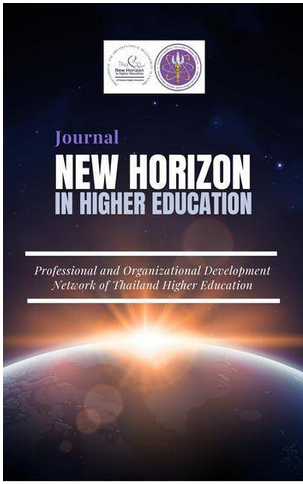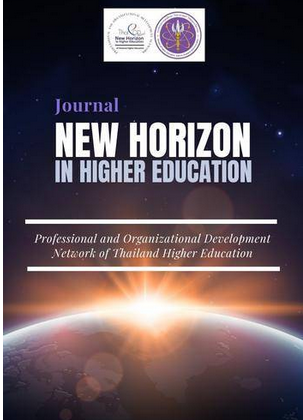In a word, the state of foresight in US higher ed is … precarious. Only a few programs have been able to maintain a long-term presence in the academic setting. Several programs have been started over the years, but they have been unable to survive very long.

But first, some background. I was asked to contribute a journal article — The State of Foresight in US Higher Education — for a new futures-oriented journal just launched in Thailand called New Horizon in Higher Education. This connection emerged from a Fulbright fellowship I did with the Thai Office of Higher Education (see blog post).
I wish I had better news to convey to my Thai colleagues. Houston and Hawaii have been the two consistent programs in the US. Several others have come and gone. There have also been many universities offering single courses on the future. My own introduction to the future came from an undergraduate course at Salem State University on “History of the Future.” The typical pattern is that an academic interested in the future would find a way to weave a course or two into their academic programs, but historically they were unable or uninterested in establishing full degree-granting programs.
A key reason for the challenging state is that Foresight is still a relatively new discipline and the current climate in US academia is not conducive to new, small, and innovative programs. On a positive note, that climate could change. There is some other good news. A new masters in Design Futures is scheduled to launch at Arizona State this fall. The World Futures Studies Federation has launched an Accreditation Service for Foresight programs. And the health of foresight in general is improving. Foresight is much stronger in the public and private sector than it is in academia in the US. Let us hope that the academic climate will improve. In the meantime, patience and persistence. -– Andy Hines

hi andy,
when I created and then got Emerald to absorb OTH, it was clear that, though it was an academic journal, the market was primarily in the private sector with a nod to the non-profits. It’s the same with the SDG’s vs the ESG’s and economics vs finance. Several of us have discussed this and one conclusion is that the languages are different and the short/long term needs are different
Emerald’s market is education qua education with a slant to the K-12 faculty. Emerald and I were growing apart when I left OTH
It is interesting that Sohail’s involvement in education and his consulting practices are divided also. Others have the same schizophrenia. Joel Barker’s future wheels popped up in the APF chat, but Joel’s strengths and success has not been in education
Hi Tom, nice to hear from you. It it somewhat hopeful that Peter Bishop’s Teach the Future has been working at the K-12 level.
The main challenge for academic forecasting is, IMHO, to project the image of impartial objectivity acceptable in the groves of academe. Forecasting is inherently judjmental. Which BTW is true of anything a human does, but in forecasting it’s just incurably obvious: we keep making forecasts based on our intuition where the available information is insufficient to know the future. Which is all the time. As Warren Buffet has put it, “Forecasts usually tell us more of the forecaster than of the forecast”.
Let’s take the Delphi method, for example. The choice of a moment to initiate a Delphi project is judgmental, and so is the choice of its topic, the choice of collaborators to set it up, the choice of selection criteria and the approach to recruiting the experts, the choice of questions to ask the experts, the experts’ choices to respond or not, the responses themselves, the choice of a method to aggregate the responses, et cetera ad infinitum. Having done all that based on one’s intuition (that can be, and often is, vigorously rationalized a posteriori using data cherry-picked, consciously or otherwise, for this purpose), one can then draw formidable-looking tables with average, mean and standard deviation – sometimes for data from fewer responders than the number of authors in the resultant paper. No I ain’t kidding, I’ve seen ’em peer-reviewed publications like that. So have you.
I think this underlines the IMHO main challenge in the field of forecasting: it has a hard time deciding if it’s a science or an art. Which makes it difficult to project a solid image – one needed to overcome the customer attitude summarized by Ken Gailbraith’s “The only function of economic forecasting is to make astrology look respectable”.
On one hand, with the prevailing preference of the customers – politicians and industry bosses – to declare their decisions to be based on science and evidence, it is tempting to look and sound like science. Peer review, publishers like Elsevier with established reputation in scientific fields, making up sophisticated terms for rather simple concepts like “AutoRegressive Integrated Moving Average” for “trend”, or “Disaggregative Policy Delphi method” for “asking around” – all of these create the aura of exclusive knowledge unavailable to the uninitiated. The initiated thrive to look solid, professional and very rational.
On the other hand, everyone knows that evidence from the future is not available today, – so the accuracy of any forecast is impossible to ascertain before it’s too late. As Yogi Berra pointed out, “It’s tough to make predictions, especially about the future.” There is no evidence from the future to tell which method yields the most precise forecast for an event that hasn’t happened yet (and may never happen). The forecasts, meantime, depend on a variety of assumptions, explicit or otherwise, the central of which can often be formulated as “all things being equal”. That is, the conditions of the past, for which data is available, are assumed to continue into the future – allowing for extrapolating the available data, linear or otherwise, into the future, and relying on this extrapolation as a forecast. But, as we are often reminded at the insistence of the SEC, past performance may not be indicative of future results. As life goes on, the “all things being equal” assumption is eventually inevitably violated (as brilliantly summarized by the collective consciousness in “sh_t happens”), leading to some rather spectacular faux pas. All things being equal, Hillary Clinton would have been sworn in as 45th president of the United States; projections based on past performance said so. Except she wasn’t. All things being equal, by 2493 CE the number of transistors in a single circuit will exceed the number of atoms in the observable Universe; projections based on past performance (Moore’s law) say so. Except it rather likely won’t.
Nvidia CEO pronounced Moore’s law dead in 2022; Intel CEO drew the opposite conclusion. This is a fork in the road: we can forecast that Intel will invest in integrating more transistors on the same chip, while Nvidia will focus on alternative approaches. The two CEOs selected from the same information and the same methods of processing it to produce their forecasts – but they made opposite judgments. Time will tell which works best.
Which is, I think, very pertinent to the predictability of disruptive events, – which Singularity is an excellent example of. There are, of course, some physical constraints on what’s possible in the real world (Heisenberg uncertainty principle, Bekenstein bound of information storage density, Bremmerman bound on the speed of digital computation, Turing limits of decidability, Godel limits on completeness and quite a few others) – and forecasting their violation, like a chip with more transistors than there are atoms in the Universe, predictably leads to embarrassment. So does forecasting uploading mind to a computer, as I explain in my book (https://www.amazon.com/Homo-Exploratoris-Humanity-Apprentice-God-ebook/dp/B09Z7F3CHT/). However, there is still a huge space of scenarios left available for us to choose from. And “us”, at least so far, means humans: humans with intuition to suggest when the assumption of “all things being equal” will be broken and factors that used to be safe to ignore would all of a sudden become as important as that space rock was for dinosaurs 65 million years ago.
Which IMHO means that if we want to learn to forecast disruptive events, turning to humans is not just the best game in town, as the paper you sent me suggests – it’s the only game in town. And turning to humans doesn’t (just) mean turning to established experts. We all remember how in the early 20th century a patent outsider revolutionized physics – which, fortunately, was at that time ready to listen. Conversely, in the early 21st century the number of disruptive works in science is in a nosedive (https://www.nature.com/articles/d41586-022-04577-5?fbclid=IwAR3Vikup5sC5UXGP0cXNr7VJ4cHcMmghjNbmMsKHBXcYSgpST92MPLuf1bE) – despite the explosive growth of the scientists’ headcount. BTW, that hints at an urgent need for a new scientific paradigm. In the book, I make a couple of suggestions on what a new paradigm might look like.
Meantime, could the newly available infrastructure of planetary consciousness, the World Wide Web, help democratize foresight and use human diversity as the resource for forecasting (and hence shaping) humanity’s future(s)? I am currently trying to get one such project off the ground, and I am sure there are others – and there will be more.
Andy, i think the big challenge is simpler than you suggest. all humans are futurists. so shocking as it may seem, even executives are futurists so they don’t really want to pay for people to do futures work. who got to be the futurist at apple besides steven jobs?
companies want colleges to produce people that help their companies operate so they hire accountants, programmers, marketers, etc.
it can kinda be summed up like this: executives think they are the crem de la crem of futures and strategy. thus, they don’t want to hire futurists or strategists.
i will say, my employer paid good money for me to bring in “futurists” under the guise of exposing the c-suite to “outside” thinking. they heard from and interacted with Jamie Canton, Eddie Wiener, Michael Schrage, Eric Haseltine, and Don Tappscott.